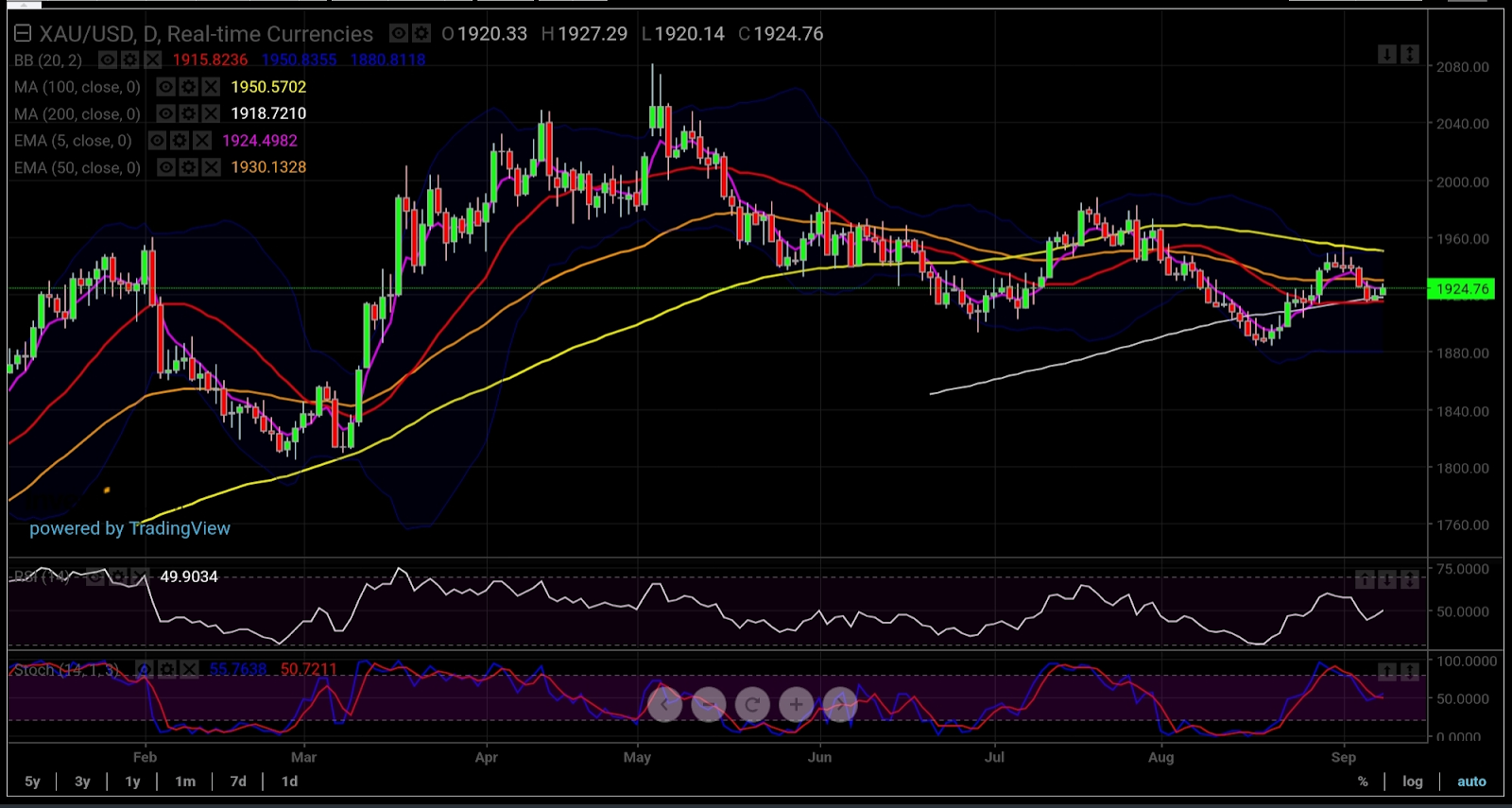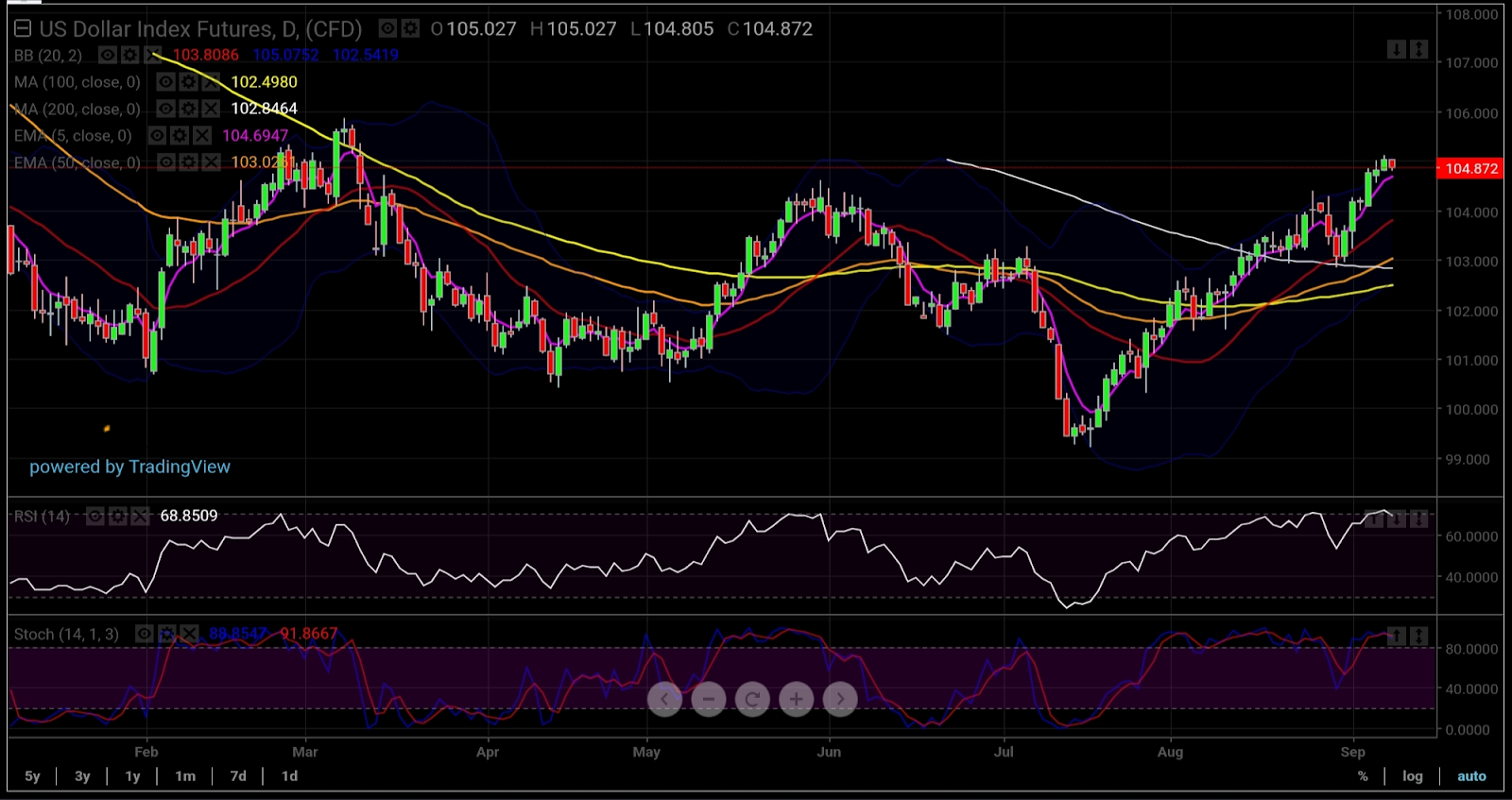- Gold prices have remained stagnant in a $15 range due to market uncertainty following the August U.S. jobs report.
- The Dollar Index's recent strength is weighing on gold, and its short-term correction could influence the dollar's direction
- Fed expected to maintain rates in September; potential 0.25% increase in November. Gold outlook tied to $1,915 support or $1,930 resistance
It’s what happens to gold when uncertainty grips the market either way.
And uncertainty is at its height after the U.S. jobs report for August suggested the Federal Reserve will sit pretty at its Sept 20 decision on rates while keeping open the option of raising rates once — or maybe twice — before the year is out.
Since the latest non-farm payrolls surfaced a week ago, the spot price of gold — more closely watched by some traders than futures — has moved just about $15 an ounce, going from a settlement of just below $1,940 on Sept. 1 to hover at $1,925 on Sept. 8.
The same $15 play is what the market needs to crack in order for a new direction to emerge. Paramount to the bears in gold now is a push of the spot price beneath the key $1,915 support. For the longs, it’s a clear break above the $1,930 resistance.  Charts by SKCharting.com, with data powered by Investing.com
Charts by SKCharting.com, with data powered by Investing.com
Sunil Kumar Dixit, chief technical strategist at SKCharting.com and a regular contributor of commodity technical readings for Investing.com characterized it this way:
“Catch me if you can … that’s the dare the bulls and bears seem to be making at each other with gold stuck in a super tight range of $15 now.”
The reason for the directionless market, of course, is the lack of compelling data and drivers to move the needle on either inflation or gold since the August payrolls numbers. The odd thing is with less than two weeks to the next Fed decision on rates, this range might actually hold.
There is one caveat, though, for this: The US dollar.  The Dollar Index hit six-months of 105.125 this week. Typically, dollar strength weighs on gold, explaining in part the yellow metal’s weakness over the past week.
The Dollar Index hit six-months of 105.125 this week. Typically, dollar strength weighs on gold, explaining in part the yellow metal’s weakness over the past week.
According to Dixit’s reading on the Dollar Index, a short-term correction could pull the greenback towards support areas of 104, 103.50, and ultimately 103 if the 104.75 - 104.50 support zone is broken.
That could, inadvertently, push the dollar higher.
On the flip side, consolidation of the index at above 104.90 could help it break above 105.12 and extend its upmove towards the March high of 105.87.
For now, though, gold doesn’t seem to have buckled too much under the weight of the dollar, raising the notion that the market was prioritizing the Fed’s signals on inflation.
Inflation and the Fed
US job openings fell to a near 2-½ year low in July, signaling a cooling in employment welcomed by the Fed in its bid to see less inflationary pressure. But jobs grew by a higher-than-expected 187,000 jobs in August, and unemployment ticked up as well to 3.8% from 3.5%.
Inflation, measured by the Consumer Price Index, or CPI, hit four-decade highs of more than 9% per annum in June 2022 due to trillions of dollars of federal relief spending following the 2020 coronavirus outbreak.
The Fed responded with its most aggressive rate hikes in 20 years, going from a base rate of just 0.25% in March 2022 to 5.5%. The Fed’s actions pushed inflation down to as low as 3% by June before they perked again to 3.2% in July.
While pandemic-related spending is in the rear-view mirror and the CPI has stabilized at around 3% per annum now, a robust labor market has allowed Americans to continue spending, preventing the Fed from achieving its target for inflation.
Fed Chairman Jerome Powell said last week the labor market's rebalancing was "incomplete." Powell has repeatedly noted that getting inflation back down to the central bank’s 2% goal will require "some softening in labor market conditions."
The Fed chief made clear that US rates will follow inflationary pressure.
“We are prepared to raise rates further if appropriate, and intend to hold policy at a restrictive level until we are confident that inflation is moving sustainably down toward our objective,” Powell said.
Most money market traders think the Fed will leave the key US lending rate unchanged at 5.5% at its September 20 meeting. But some 43% in a poll said the central bank will likely opt for a 0.25 percentage point increase at its November policy meeting.
Spot Gold Outlook
Dixit said the previous week's bullish momentum failed to establish a clear break for spot gold above the 100-day SMA, or Simple Moving Average.
The same applied to the Weekly Middle Bollinger Band, causing rejection from the key resistance of $1,954, which dropped gold to the Daily Middle Bollinger Band of $1,915.
Dixit said spot gold’s current technical bounce back from $1,915 was likely to be challenged at the immediate resistance of the 50-day EMA, or Exponential Moving Average, of $1,930.
“If the spot gold finds enough buying support above $1,930, upward mobility can extend it towards the next leg higher, marked by the 100-day descending SMA of $1,950.”
“Further stability will be required above the $1,950-$1,955 level for a major upside target of $1,970-$1,975.”
On the flip side, failing to make a sustainable break above $1,930 will prompt a retest of the Daily Middle Bollinger Band of $1,915, and a break below the previous week's low of $1,912 will clear the way for the next leg lower at the 50-week EMA of $1,899.
If selling intensifies below $1,899, the next major support is seen at the Monthly Middle Bollinger Band of $1,858.
***
Disclaimer: The aim of this article is purely to inform and does not in any way represent an inducement or recommendation to buy or sell any commodity or its related securities. The author Barani Krishnan does not hold a position in the commodities and securities he writes about. He typically uses a range of views outside his own to bring diversity to his analysis of any market. For neutrality, he sometimes presents contrarian views and market variables.
